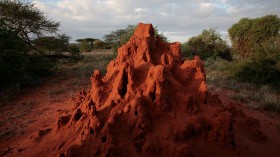Researchers have identified a new species of rosy-colored deep-sea worm 30 miles (50 kilometers) off the Pacific coast of Costa Rica.
The worm, Pectinereis strickrotti, is a ragworm (Nereididae).
Discovery Of New Species
The species was discovered by researchers in 2009 while exploring a methane seep at a depth of 3,280 feet (1,000 meters) aboard a deep-sea submersible named Alvin.
In 2019, the team went to the same region and spotted six more of the critters, allowing them to take the photographs, videos, and samples needed to formally designate P. strickrotti as a new species.
"We saw two worms near each other about a sub's length away swimming just off the bottom. We couldn't see them well and tried to creep in for a closer look, but it's hard to creep in a submarine and we spooked them," said Bruce Strickrott, the lead pilot for Alvin at the Woods Hole Oceanographic Institution in Massachusetts and whom the species is named after.
P. strickrotti has a segmented, elongated body that measures approximately 4 inches (10 cm) long. Like other ragworms, it resembles a hybrid between a centipede and an earthworm.
The species, like many other ragworms, lives in aquatic habitats, although it prefers deep seas over shallower waters.
On either side of its body, it bears a series of feather-like outgrowths called parapodia, which are capped with gills that allow it to collect oxygen from water.
It also has a secret collection of "pincer-shaped" jaws that may be thrust out when they need to catch something to eat, although scientists don't yet know what their diet consists of.
The scientists discovered that P. strickrotti swims like a snake, with many bends and turns as it glides through the water.
They appeared "rosy" under the lights of the submersible Alvin, most likely due to the color of their blood. P. strickrotti, unlike other ragworms, is blind because it lives in utter darkness at such great depths.
Read Also: 130 Million Years Fossils Show Rare Early Deep-Sea Species Activities During Dinosaur Time
Species In Costa Rica
Since 2009, the team has discovered over 450 species of Costa Rican methane seeps, with 48 of them being newly discovered.
Methane seeps are areas on the seafloor where the powerful greenhouse gas methane escapes from rocks or sediment in the form of bubbles.
Unlike deep-sea hydrothermal vents, methane seeps are usually not hotter than the surrounding water. However, like hydrothermal vents, methane seep habitats are powered by chemical energy rather than sunlight.
This is because certain microorganisms have evolved the ability to consume methane. The bacteria that can convert methane into food form the foundation of a food web that, at the Costa Rican seeps, is dominated by mussels, crabs, and soft-bodied polychaete worms like this new species.
Greg Rouse, a marine biologist at the University of California, San Diego's Scripps Institute of Oceanography, said the team spent years attempting to define and explain the biodiversity of the deep water.
"At this point we have found more new species than we have time to name and describe. It just shows how much undiscovered biodiversity is out there. We need to keep exploring the deep sea and to protect it," he added.
The crew intends to return to sea later this year with the goal of making additional deep-sea discoveries at methane seeps off the shores of Alaska and Chile.
Related Article: Poisonous Deep Sea Creatures Spotted In The Shores Of India, Public Warned Not To Touch The Species
© 2024 NatureWorldNews.com All rights reserved. Do not reproduce without permission.





